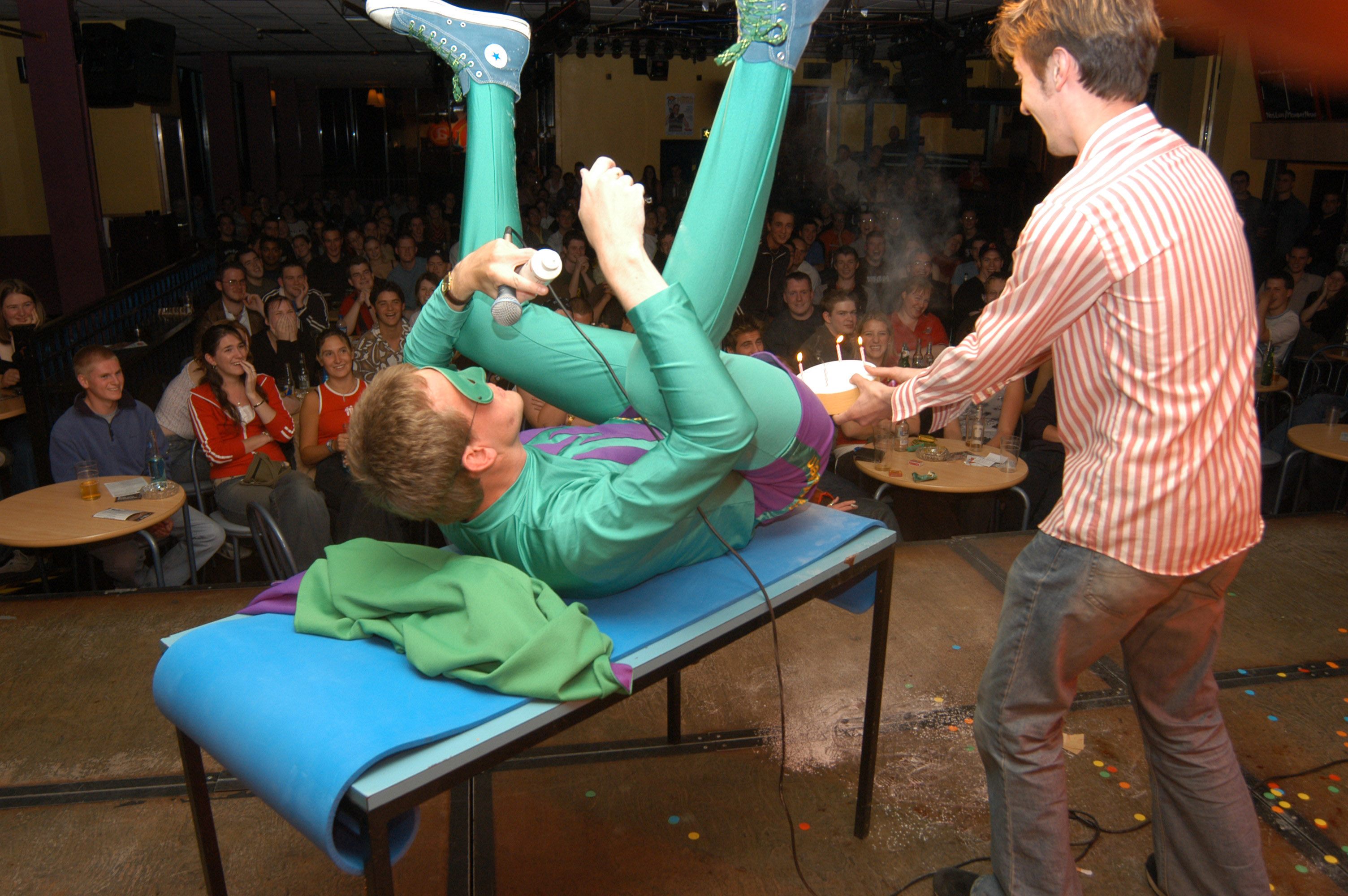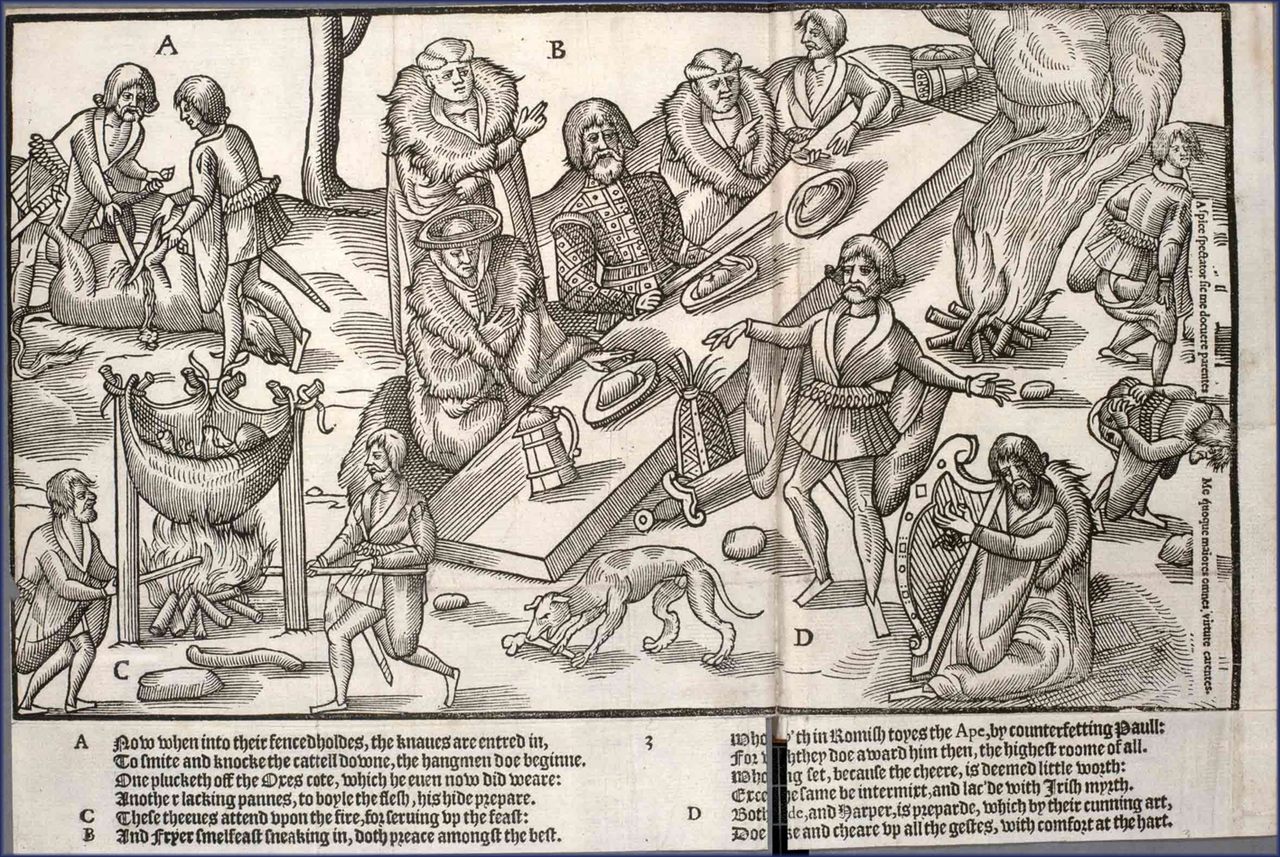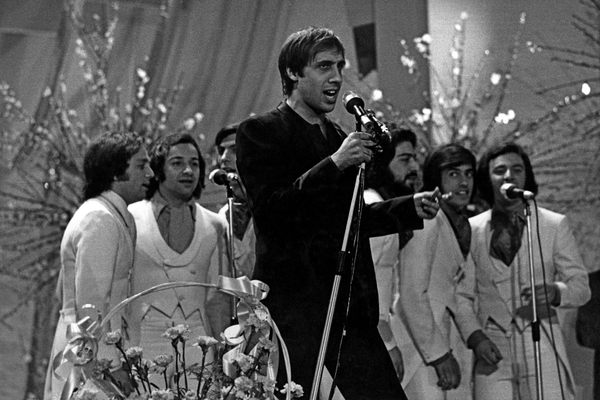The True Story of Roland the Farter, and How the Internet Killed Professional Flatulence
Roland, court minstrel to 12th century English king Henry II, probably had many talents.
But history has recorded only one.
Referred to variously Rowland le Sarcere, Roland le Fartere, Roland le Petour, and Roland the Farter, Roland really had a single job in the court: Every Christmas, during the court’s riotous pageant, he performed a dance that ended with “one jump, one whistle, and one fart” executed simultaneously.

For this, Roland was gifted a manor house in Hemingstone, Suffolk, and more than 100 acres of land. For farting on cue.
Farts are and have always been funny—an odiferous, invisible thread in the rich tapestry of global comic tradition. They are funny in virtually every culture, every language, every era. The oldest joke in the world, according to the University of Wolverhampton, is a fart joke: “Something which has never occurred since time immemorial; a young woman did not fart in her husband’s lap” would have cracked up the Sumerians of 1900 BC. Master Athenian playwright Aristophanes peppered his comic plays with fart jokes, as did Shakespeare. Geoffrey Chaucer used well-placed farts to puncture pretension in his Canterbury Tales, and at least two stories in the Thousand and One Nights hinge on farts. An ode to a fart in Parliament from 1607 was popular for decades after the fart itself had dissipated; François Rabelais’s stories of Gargantua and Pantagruel reek of farts; Mark Twain’s fart joke, a mock-Elizabethan diary entry titled “1601” or “Conversation as it was by the Social Fireside in the Time of the Tudors,” was long considered unprintable, featuring as it did Queen Elizabeth sputtering, “Verily in mine eight and sixty yeres have I not heard the fellow to this fart.”
The 1942 Bing Crosby and Bob Hope vehicle, Road to Morocco, got big laughs out of a whoopee cushion gag. In a 2007 interview with The New York Times, Sarah Silverman called fart jokes “the sign language of comedy” and her 2009 book is called Eat, Pray, Fart. The World Fart Championships are—or at least were, in 2013—a thing in Finland. Farts are funny and they’re everywhere.
However, most of that kind of fart humor hinges on the unexpectedness of the fart, and the subsequent shock, shame, and giddy embarrassment it engenders. So what about Roland and the rare others like him, the performance fartists?
The historical record of Roland is rather thin, although the bones of it are likely true. Valerie Allen, professor of literature at the John Jay College of Criminal Justice, investigated Roland’s story in her 2007 book, On Farting: Language and Laughter in the Middle Ages. Roland’s timeline was, she said, difficult to determine: He was possibly first in service to King Henry I, and then to Henry II; fee ledgers from the era indicate what kind of payment he received and for what, but don’t give dates. A later king, supposed to be Henry III, however, was not as amused by Roland’s talent and, on the grounds that the service was “indecent,” the Crown took his land and manor back.
This, however, is a timeline that has the poor man farting at court over a period of more than 120 years. Allen notes that Roland’s actual history and which of the Henrys actually enjoyed his talents is a matter of mystery. But Roland’s story still captivates; Allen is firm about his appeal (“he’s a much loved figure”) and subsequent historians and chroniclers over the last 900 years have enjoyed retelling the story of Roland the Farter.
Farting in the Middle Ages was a more complicated act than in this century. Then, as now, Allen said, much of the humor in farts had to do with anxiety over uncontrollable bodies and the hilarious reminder that everyone, even the loftiest in feudal society, couldn’t escape them. But there was a more sober, philosophical side to medieval farts, one that isn’t so evident today. “[Gas] is the product of decomposition, so morally, theologically, a lot of the writers in the Middle Ages saw it as the mark of death,” she says, “There was a lot of moralization about farts and shit, that they are the living daily reminder that we are going to die and that’s all we are, we are mortal, and sinful as well.”
More the stuff of Sunday sermons than mid-winter revels. But Roland’s act was also grounded in a tradition of widely varied entertainment at court. Jugglers, fire-eaters, storytellers, acrobats—some of them, men and women, performed in the nude—comedians, music-makers, and farters were all part of the medieval performance scene. Irish records from the 8th century list “farters” (bruigedoire) as among the types of retainers found at courts, and note that their pay should be the “fat of the shoulder” of hunted prey. At roughly the same time Roland was earning his manor house, a group of Irish farters (braigetori) were described occupying a table at the banqueting hall of the High King of Ireland.
“Not all performing farters were land-owners,” cautions Allen, but there was an established, if not profession, at least specialty. “I should think that for festive occasions this kind of entertainment was central and necessary and must have involved high degrees of skills, a whole range of performance tricks,” she says, “They’re like circus performers.”
The tradition appears to go back even further: St. Augustine of Hippo, writing City of God in the 5th century, noted people who could “ produce at will such musical sounds from their behind (without any stink) that they seem to be singing from the region.” And, like fart humor in general, it’s not limited to Western culture. In her book, Allen mentions an illustrated scroll based on “The King of Farts,” a tale from Japan’s Kamakura era (1185 to 1333), featuring one Fukutomi no Oribe, who “performed fart dances for the aristocracy” and “trumped his neighbor Toda who tried to mimic the master farter, but soiled himself instead.”
That was fiction, but there were actual documented flatulists at work in Japan by the 1700s. During the Edo period, Tokyo streets were full of misemono, attractions that sometimes featured the kind of people who would later populate “freak shows”; one of the more popular misemono stars was a man called Kirifuri-hanasaki-otoko, meaning “the mist-descending flower-blossom man,” who, in 1774, demonstrated his ability to take in quantities of air and release it in “modulated flatulent arias,” according to the late professor Andrew Markus of the University of Washington. (Farts were a bit of a thing in the Edo period: A series of illustrated scrolls from the time, made by artists unknown, is titled “He-Gassen,” or “Fart Battle,” and is precisely, hilariously what it sounds like it is.)
The next biggest name in farting was a fin de siècle Marseilles man who called himself Le Pétomane—literally, “the maniac farter.” Young Joseph Pujol, the son of a baker, discovered his talent when swimming near his home on the Cote d’Azur. According to Retro magazine, he’d just taken a deep breath to dive under the waves when he felt a cold sensation creeping up his back passage—it was sea water, which he’d “inhaled” with his sphincter. At first, Pujol used his talent to shoot water incredible distances (as far as five meters by the time he was an adult), but he soon discovered that he could take in air and release it how he wanted. After a career in the Army, where his talent naturally blossomed, he began performing at local music halls, tooting out “La Marseilles” and “Au Clair de Lune” and doing “impressions.” By the time he made it to Paris in 1892, he was already big enough to book a 90-minute show at the infamous Moulin Rouge.

“He dressed in a tuxedo and announced each sound as if he were presenting a music solo. Of course, the incongruence of a dignified gentleman letting farts only added to the humor,” wrote Jim Dawson, music journalist and self-titled fartologist who is the author of Who Cut the Cheese? (1999) and Blame It on the Dog (2006), in an email. Pujol didn’t only toot songs and impressions of “thunder”—he could smoke a cigarette with his bottom and blow out candles and even the gas jets in the footlights. Some women fainted (lore has it that Moulin Rouge stationed nurses in the aisle) but audience members of both sexes roared with laughter.
When not performing at the Moulin Rouge, Le Pétomane did private shows in the nude for curious wealthy gentlemen who wanted to know what was going on under his tuxedo tails. Pujol became one of the best paid performers in Paris, if not the world, and his exceptional ability was studied by curious physicians; one published a report on Pujol in 1904 fantastically entitled “An Extraordinary Case of Rectal Breathing and of Musical Anus.” Three years after his first performance at Moulin Rouge, however, the club’s owner sued Pujol for “breach of contract” for giving an impromptu performance at a nearby gingerbread stall. Pujol settled and opened his own nightclub, but his celebrated career was cut short by World War I. He died in 1945, at the age of 88. The story of his life was made into a short film in 1979 starring British comedian Leonard Rossiter.
Beloved though Le Pétomane was by nearly everyone, this wasn’t sophisticated humor. “Obviously, in the comedy hierarchy, farting is near the bottom (ahem), along with cat jugglers and clowns,” says Dawson. “I don’t think a farter can sustain a regular legion of fans. Once you’ve seen the act, your primary motive for going back is to take your friends and watch their expressions.”
And still does. The tradition of the flatulist didn’t die with Le Pétomane, although it is struggling.
Paul Oldfield, known professionally as Mr. Methane, has been a performing flatulist since 1991. His Facebook fanpage—nearly 4,000 likes—features video clips of his 2009 performance on Britain’s Got Talent (Oldfield didn’t win, which would have meant he performed at the Royal Variety Show for the Queen; one wonders how modern royalty would react to his talents); the cover picture features lanky 6-foot-7-inch Oldfield in his purple and green superhero costume, his arms around several attractive young women.
Speaking on the phone from his home in the north of England, Oldfield can’t seem to stop himself from making fart-related puns. He tends to be long-winded (sorry), but he’s got a good story to tell and a kind Northern accent.

Oldfield, like Le Pétomane before him, is able to “inhale” air into his sphincter and then push it back out again in, he says, “three tones” (and without smell, given that the air is not coming from digesting food in his stomach). How exactly he “inhales” is hard to explain, he says—it’s a combination of relaxing and tightening his sphincter and diaphragm that he can just do. “You’re going in reverse, so to speak, you draw the air into your colon, and then you trap it off, then you tighten the sphincter muscle. You then squeeze it out, and you can alter the sound,” he says. “A bit like blowing raspberries with your mouth.” It’s physically demanding work, which means that he exercises frequently, usually doing yoga and stretches: “You need to stay farting fit, don’t you?” he deadpans. “The puns are endless, aren’t they?” But you can’t laugh, he cautioned: “You’re using your diaphragm, once the top end is laughing uncontrollably, there’s no control downstairs. It’s hard enough as it is when you’re being serious.”
According to Oldfield, he discovered his talent doing yoga in his teens—“in the full Lotus position,” he adds—and used to pull pranks at school during lunchtime “for pocket money.” After a brief career as a train engineer, he had the eureka moment: “What the hell, wouldn’t it be good, I’ll see if I could make a living as a professional farter.”
Oldfield adopted a superhero persona, Mr. Methane, complete with green cape and mask, perfected his pun-filled patter, and began performing at friends’ parties, university end-of-year bashes, and corporate events. One of his first big gigs was at the Screaming Beaver in Macclesfield in Cheshire, a club that had seen the likes of Steve Coogan perform. “For some reason they kept getting these different ground-breaking acts, and they thought I would be one of these ground-breaking acts, but as it was I was just a wind-breaking act,” he says.
Gigs led to other gigs, and soon Mr. Methane was on TV, doing the late night chat show circuit around Europe. He, like the few other professional farters, was a favorite of shock jock radio hosts, including Howard Stern, throughout the late ‘90s and early 2000s. He’s done television shows across the world, appeared in adverts for Cadbury’s chocolate and guest-starred on sit-coms, performed at the Reading Festival and Edinburgh Fringe, even made a Christmas album. Sinead O’Connor was reportedly a fan and ordered 20 copies each of his mrmethane.com album, Merry Methane and his Let’s Rip DVD.
But in many ways, he’s a performer from a long-past era, when variety shows and music halls were thriving, jazz came in trios, and pubs and clubs were willing to take a chance on a performer with an outré talent. “I’d probably have had a lot more live work in the ‘60s and ‘70s and maybe the ‘80s, so maybe I have come too late,” he agrees. And now, while the odd TV gig still comes in, much of his bread-and-butter work has dried up—due in some part, he believes, to YouTube.
Though Oldfield’s act is almost tailor-made for social sharing, the new Internet era hasn’t been a positive. The constant stream of crazy online streaming clips has eliminated the need for clubs to book him. “While we’ve been chatting there will be all these people who’ve watched clips of me and that’s the mind-blowing thing about the internet—you’re being watched much more than you’d ever have been in the past,” he reflected. “Now you’re being watched and you’re not earning any money. It’s not even being exploited, it’s being consumed, and you’re not earning any money from it. It’s a strange one.”
What he’ll do next, he doesn’t know. It might be about the time to hang up his green mask and purple fart shorts. “Maybe it’s time for a new Mini-Methane, who can take it into the new era,” he muses. “I’ve been telling a joke basically with one punch line and somehow I’ve been able to tell it for about 25 years as a performer, so I don’t think I’ve done too bad.”
This story originally ran in 2015; it has been updated for 2022.















Follow us on Twitter to get the latest on the world's hidden wonders.
Like us on Facebook to get the latest on the world's hidden wonders.
Follow us on Twitter Like us on Facebook